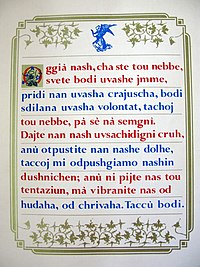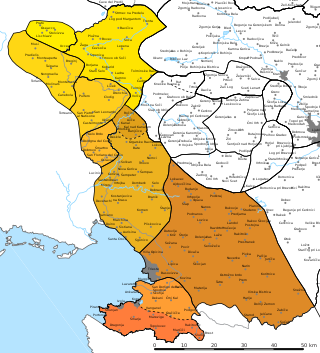
Back Resianisch German Résian French Dialet rosean FUR Rezijanski jezik Croatian Réziai nyelv Hungarian Dialetto resiano Italian Dialett resian LMO Dialekt rezjański Polish Резьянский диалект Russian Rezijansko narečje Slovenian
| Resian | |
|---|---|
| Rozajanski langäč / Rozojanski langäč | |
 Pater Noster in the old Resian dialect | |
| Native to | Italy |
| Region | Resia valley |
| Ethnicity | Resians[1] |
Native speakers | 929 (2022)[2] |
Indo-European
| |
Early forms | Northwestern Slovene dialect
|
| Dialects |
|
| Latin | |
| Official status | |
Recognised minority language in | |
| Regulated by | University of Padua[3] |
| Language codes | |
| ISO 639-3 | – |
| Glottolog | resi1246 |
| IETF | sl-rozaj |
 The Resian dialect | |
| South Slavic languages and dialects |
|---|
The Resian dialect or simply Resian (self-designation Standard Rozajanski langäč / Rozojanski langäč, Bila Rozajanski langäč / Rozojanski langäč, Osoanë Rozoanske langäč, Solbica Rozajonski langeč / Rozojonski langeč;[3] Slovene: rezijansko narečje [ɾɛziˈjáːnskɔ naˈɾéːt͡ʃjɛ], rezijanščina; Italian: Dialetto Resiano) is a distinct variety in the South Slavic continuum, generally considered a Slovene dialect spoken in the Resia Valley, Province of Udine, Italy, close to the border with Slovenia.[4][5][6]
Together with the Rosen Valley dialect and Ebriach dialect in Carinthia, it is one of the three dialects of Slovene spoken entirely outside the borders of Slovenia. It is unequivocally one of the most unique and difficult dialects to understand for speakers of central Slovene dialects, especially because most Resians are not familiar with standard Slovene.[7] Its distinguishing characteristic is centralized, breathy vowels.[8] It borders the Slovene Torre Valley dialect to the south and the Soča dialect to the east, both separated by tall mountain ranges.[9] On the other sides, it mostly borders Friulian, but also Bavarian to the north. It belongs to the Littoral dialect group, although it shows few similarities with other Littoral dialects and evolved from the Carinthian dialect base, northern Slovene, as opposed to other Littoral dialects, which evolved either from western or southern Slovene. It is spoken by fewer than a thousand people and is listed as a definitely endangered language according to UNESCO's Atlas of the World's Languages in Danger.[10] Despite this, Resians value their language and it is being passed down to younger generations.[7]
- ^ ""Siamo resiani e non sloveni" Mille firme per un referendum" ["We are Resians and not Slovenians" One thousand signatures for a referendum]. Il Messaggero. February 5, 2004.
- ^ "Popolazione residente al 1° Gennaio 2022 per sesso, età e stato civile - dati provvisori; Comune: Resia" [Resident population on 1st January 2022 by gender, age and marital status – data provider; Comune: Resia]. Istituto Nazionale di Statistica (in Italian and English). 1 January 2022. Archived from the original on 11 August 2022. Retrieved 13 August 2022.
- ^ a b Steenwijk, Han (15 April 2004). "Resian dictionary". Resianica (in English, Italian, and Slovenian). University of Padua. Archived from the original on 19 January 2022. Retrieved 13 August 2022.
- ^ Steenwijk (1992a:1)
- ^ Pronk, Tijmen (2009). The Slovene Dialect of Egg and Potschach in the Gailtal, Austria. Amsterdam: Rodopi. p. 2.
- ^ Stankiewicz, Edward (1986). The Slavic Languages: Unity in Diversity. Berlin: Mouton de Gruyter. p. 93.
- ^ a b Logar (1996:231)
- ^ Logar (1996:4)
- ^ "Karta slovenskih narečij z večjimi naselji" (PDF). Fran.si. Inštitut za slovenski jezik Frana Ramovša ZRC SAZU. Retrieved June 8, 2020.
- ^ Interactive Atlas of the World's Languages in Danger, UNESCO's Endangered Languages Programme, retrieved 2015-10-17
© MMXXIII Rich X Search. We shall prevail. All rights reserved. Rich X Search